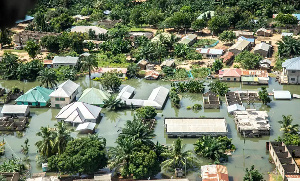Opinions of Wednesday, 25 October 2023
Columnist: Lambert Donkor
A call for a coordinated disaster risk reduction approach in Ghana: Lessons from the Akosombo/Kpong Dam spillage.
The Akosombo/Kpong Dam Spillage has recently thrust into the spotlight the dire need for a coordinated approach to disaster risk reduction in Ghana. This incident has emphasized the potentially catastrophic outcomes of not addressing looming disasters promptly and effectively.
To this end, there are crucial steps that must be taken to minimise the impact of such disasters in the future.
Establish an Inter-Ministerial Committee: To effectively address dam spillages, it is crucial to set up an Inter-Ministerial Committee well in advance of any spillage. The Akosombo/Kpong Dam is not just an environmental concern; it is also a significant national security issue.
Regardless of the natural forces involved, the consequences of a dam spillage would be classified as a man-made disaster. This committee should comprise representatives from various government ministries and agencies to ensure a holistic approach to disaster risk reduction.
Activate a National Emergency Preparedness Plan: A timely and well-coordinated National Emergency Preparedness Plan is vital. This plan should clearly outline the roles and responsibilities of all relevant agencies and stakeholders in the event of a dam spillage. Having a well-defined plan in place is essential to respond effectively to such emergencies.
Undertake Risk Communication Mobilization: A comprehensive risk communication campaign is essential to educate and sensitize communities likely to be affected by a spillage. This campaign should utilize all available media channels and engage with communities directly to ensure that people understand the implications of the impending disaster in simple terms. Encouraging self-evacuation ahead of the spillage is crucial.
Establish Safe Havens: The responsibility of building temporary safe shelters, known as safe havens, should be shared among the state, private institutions, and corporate entities. Disaster risk reduction should be a collective effort, and these shelters can provide a safe refuge for those affected by the spillage.
Plan for Comprehensive Health Promotion: In disaster situations, access to quality healthcare is of paramount importance. A comprehensive health promotion exercise should be planned to ensure that healthcare services are readily available and accessible during and after the disaster.
Launch a National Relief Fund: A National Relief Fund should be established to ensure that resources are readily available to assist affected victims. This fund can serve as a vital lifeline for individuals and communities in the wake of a disaster.
Identify a Central Point for Relief Coordination: To avoid leaving any affected victims behind, a central point for relief coordination should be identified and prepared. This central point can serve as a hub for coordinating relief efforts and ensuring that assistance reaches all those in need.
Implement Forced Evacuation: As part of the overall strategy, a forced evacuation plan should be put in place weeks before the spillage is expected. While many community members may self-evacuate, there may be some who resist or delay evacuation. A task force can be used to ensure that all individuals are evacuated to safety.
Timing and Activation: All of these measures should be activated promptly, ideally following a simulation exercise held in May 2023 by organizations such as the National Disaster Management Organization (NADMO), Volta River Authority (VRA), Municipal Assemblies, and other security agencies. Such exercises are crucial for testing the capabilities of emergency response agencies and identifying gaps for planning purposes.
Global Standards for Sustainable Development and National Security: Ghana should embrace a coordinated approach to disaster risk reduction that aligns with global standards for promoting sustainable development and national security. The Akosombo/Kpong Dam Spillage should serve as a wake-up call for the Ghanaian government, individuals, and corporate institutions to invest wisely and promptly in disaster risk reduction.
A Resilient Nation: A nation that prioritizes disaster risk reduction is a step ahead in building resilience. The impact of the disaster from the spillage could have been mitigated significantly if Ghana had taken a more proactive approach to national security and disaster risk reduction.
As a result, Ghana now finds itself in an undeniable state of emergency.
The President of the Republic of Ghana, His Excellency Akufo Addo, must not delay in declaring a state of emergency to garner support beyond government interventions. Without this, it will be difficult for the government to help the vulnerable in rebuilding their lives and sustaining the strength of the Akosombo and Kpong Dams. It is a matter of national urgency and security.
In conclusion, the Akosombo/Kpong Dam Spillage has highlighted the critical need for a coordinated disaster risk reduction approach in Ghana. By taking these measures, Ghana can better prepare for and mitigate the impact of future disasters, thereby safeguarding its citizens and national security.
Entertainment










